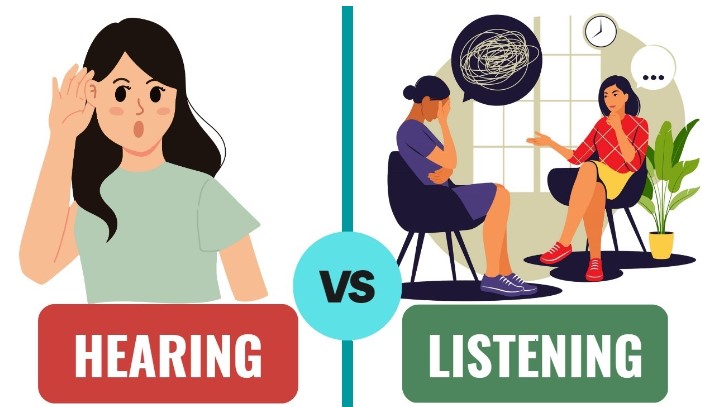Hear vs. Listen
Hear vs. Listen: Understanding the Difference and Why It Matters
SELF HELPFUN READPRODUCTIVITY
9/30/20233 min read


Hear vs. Listen: Understanding the Difference and Why It Matters
Hearing and listening are two distinct processes, often used interchangeably but with vastly different implications. While both involve perceiving sound, listening goes beyond mere auditory sensation to encompass understanding, intention, and engagement. In this article, we will explore the fundamental differences between hearing and listening, the importance of active listening, and how improving your listening skills can enhance your personal and professional relationships.
Hearing: The Passive Act of Receiving Sound
Hearing is the physiological process of perceiving sound through our ears. It is an automatic and involuntary response that occurs when sound waves reach our ears and are converted into electrical signals that our brain interprets. Hearing is a natural ability possessed by all humans, and it requires no conscious effort. In essence, hearing is the basic act of detecting sounds in the environment, whether it's the chirping of birds, the hum of traffic, or the voices of people around us.
Listening: The Active Engagement with Sound
Listening, on the other hand, is a cognitive and voluntary process that goes beyond mere hearing. It involves focused attention and an intention to understand or interpret the sounds we hear. Listening requires not only the ears but also the mind. It's an active engagement with the auditory input, where we process, analyze, and make sense of the information conveyed through sound.
Key Differences Between Hearing and Listening
Involvement: Hearing is passive, while listening is active. When you listen, you consciously choose to engage with the sound and assign meaning to it.
Attention: Listening requires attention and concentration. You tune in to the speaker or the source of sound, blocking out distractions, and focusing on what's being said.
Intention: Listening is purposeful. It often involves the intention to understand, empathize, or respond to the message conveyed through sound.
Processing: When you listen, you process and interpret the information you hear. You may ask questions, seek clarification, or form opinions based on what you've heard.
Memory: Listening enhances memory. Active listening can help you remember details, ideas, and emotions associated with what you've heard.
Why Active Listening Matters
Active listening is a crucial skill in both personal and professional settings, and here's why:
Effective Communication: Active listening fosters effective communication. It ensures that messages are accurately received and understood, reducing the chances of miscommunication or misunderstandings.
Building Relationships: When you listen actively, you show respect and empathy for others. It strengthens interpersonal relationships by making people feel heard and valued.
Conflict Resolution: Active listening is a cornerstone of conflict resolution. It allows parties to express their concerns, leading to constructive dialogue and problem-solving.
Learning and Growth: Active listening promotes continuous learning and personal growth. It enables you to gather information, acquire new knowledge, and broaden your perspectives.
Professional Success: In the workplace, active listening is a valuable skill for leadership, teamwork, and customer service. It helps build trust, resolve issues, and drive productivity.
Practical Tips for Improving Listening Skills
Give Your Full Attention: Minimize distractions and focus solely on the speaker or source of sound.
Maintain Eye Contact: In face-to-face interactions, maintain appropriate eye contact to show your engagement and interest.
Avoid Interrupting: Let the speaker finish their thoughts before responding. Avoid interrupting or formulating your response while they're speaking.
Ask Open-Ended Questions: Encourage further conversation by asking open-ended questions that require more than a yes-or-no answer.
Paraphrase and Summarize: Periodically paraphrase or summarize what you've heard to confirm your understanding and show that you're actively listening.
Empathize: Try to understand the emotions and perspectives behind the words. Empathy deepens the connection between you and the speaker.
Hearing and listening are distinct processes with significant implications for communication and relationships. While hearing is automatic and passive, listening is an active and intentional engagement with sound. Developing strong listening skills can enhance your personal and professional interactions, leading to better communication, improved relationships, and greater success in various aspects of life. So, the next time you find yourself in a conversation, remember that true understanding and connection come from active listening, not just hearing the words spoken.
